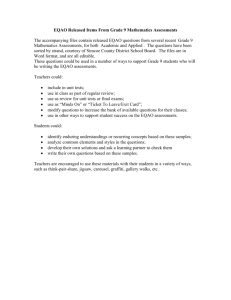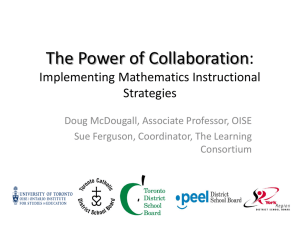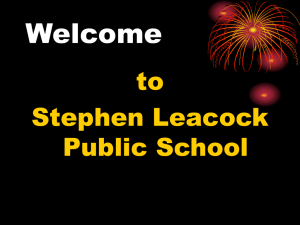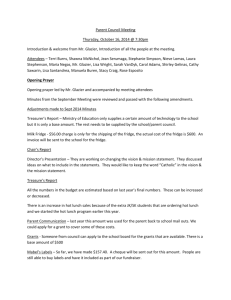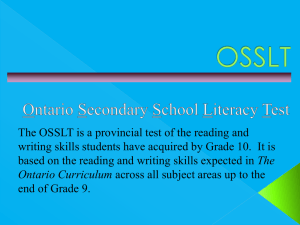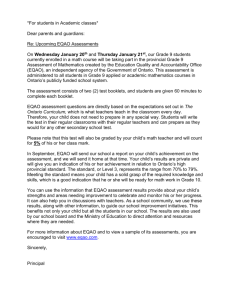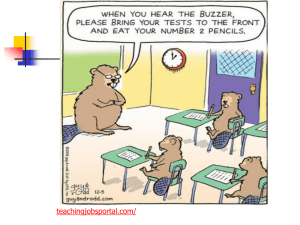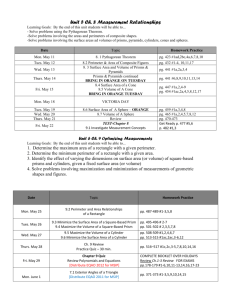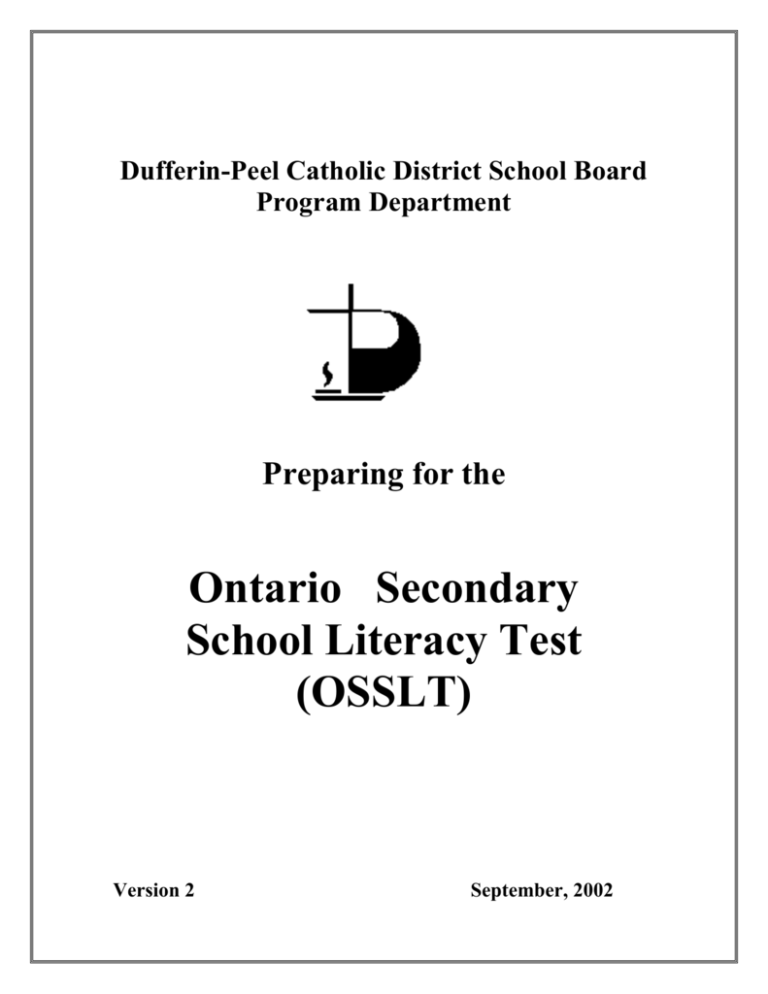
Dufferin-Peel Catholic District School Board
Program Department
Preparing for the
Ontario Secondary
School Literacy Test
(OSSLT)
Version 2
September, 2002
DUFFERIN-PEEL CATHOLIC DISTRICT SCHOOL
BOARD
PROGRAM DEPARTMENT
September, 2002
Superintendent of Program
Brendan Barnet
Principal Secondary Program and Continuing/Alternative Education
Michael Huckson
This document has been prepared with thanks to:
Yvonne Bienko
Sonia Rebellato
Secondary Program Department
Materials contained in this document are based on activities from the Education
Quality and Accountability (EQAO) website:
www.eqao.com
Rationale
Successful completion of the Ontario Secondary School Literacy Test (OSSLT) is a
secondary school diploma requirement for students who began grade 9 during the 20002001 school year and for those who begin it thereafter.
This package has been developed as a resource for teachers to use in working with
students that are preparing to write the Ontario Secondary School Literacy Test (OSSLT)
on October 23 and October 24, 2002.
Schools are to ensure that all students have access to student preparation materials
provided by EQAO activities have been taken from the EQAO website.
Teachers
This package has been prepared as a 10-hour resource to support you in preparing
students to write the OSSLT in October. EQAO results indicate that a number of students
were not successful last year because they did not properly address the test (i.e. read the
questions, follow instructions, etc.)
These lessons therefore focus on the effective writing of the test and are not intended to
upgrade literacy skills.
Each lesson is one hour in length. Master copies have been included in the lessons that
you will need to photocopy for your students. Answers sheets have been provided for
each of the quizzes with the exception of ‘Tent Tension’ as EQAO has not provided one.
This is Version 2 of Preparing for the Ontario Secondary School Literacy Test and at the
conclusion of your session you will be asked to complete an evaluation form to provide
instructor feedback and comment on the effectiveness of this resource.
Activity Overview
Activity 1: ......................................................................................................................4
Introduction to Preparing for the OSSLT - 60 minutes
Activity 2: ......................................................................................................................8
Reading A - 60 minutes
Activity 3: ......................................................................................................................13
Reading B - 60 minutes
Activity 4: ......................................................................................................................23
Reading C - 60 minutes
Activity 5: ......................................................................................................................32
Writing A - 60 minutes
Activity 6: ......................................................................................................................36
Writing B - 60 minutes
Activity 7: .......................................................................................................................41
Writing C - 60 minutes
Activity 8: ......................................................................................................................50
Writing D - 60 minutes
Activity 9: ......................................................................................................................56
Reading and Writing Using Annotated Student Responses – 60 minutes
Activity 10: .....................................................................................................................76
Conclusion to Preparing for the Reading & Writing Test - 60 minutes
Key Resource EQAO website
www.eqao.com
Additional Resources
Language Works 9 Workbook
Robert Cutting
Prentice Hall
Language Works 10 Workbook
Robert Cutting & Robin Pearson
Prentice Hall
Literacy Skills Test Preparation Workbook
Cathy Costello & Noeline Laccetti
Harcourt Canada
Reaching Higher: Supporting Student Achievement in Literacy
Dufferin-Peel Catholic District School Board
www.eqao.com
Getting Ready Guide
Support Materials: Preparing for the Test
Sample Student Answers from October 2000 Trial Administration
Activity 1: Introduction to Preparing for the OSSLT
Time: 60 minutes
Planning Notes
While students will have a limited amount of time to complete the EQAO Reading & Writing
Test, it is important that students follow instructions carefully. The Ontario Secondary School
Literacy Test Resource Guide, 2000-2001 states, “Many students lost significant potential marks
either because they did not complete some of the tasks or because the work they provided was not
consistent with the form or topic of the given task.”
Teaching/Learning Strategies
1. The teacher will direct students to read the instructions on the Preparing for the OSSLT sheet
and complete as much of it as possible in three minutes.
2. Upon completion, the teacher will discuss observations made during the activity. (Most
likely some students disregarded the instructions and immediately began the work.)
3. The teacher will advise students that the literacy pilot tests revealed errors could have been
avoided had students followed instructions. E.g. If asked to write a news report and a student
writes an editorial, has the task been completed? Can it be marked? (No, in both cases).
4. The teacher will advise students to recognize they need to be as careful as possible within a
given, limited time. Sometimes those extra few minutes at the beginning, taken to understand
the task, save time in the long run.
5. The teacher will compare the reading & writing test to preparing for a trip out of town. Just
as a student would find out about the location to be visited and prepare what to take, so
should a student investigate and prepare for the reading & writing test.
6. Part of that preparation includes having students reflect on their abilities as readers and
writers. Students will write their strong points that reveal what makes them a good reader
and a good writer.
7. The teacher will share the reading & writing test set-up.
Three types of reading selections:
Literary (story, description, tables)
Information (explanation, instructions)
Graphic (schedules, graphs, tables)
Four different written pieces:
News Report
Information Paragraph
Summary
Series of Paragraphs Expressing an Opinion
8. The teacher will distribute EQAO’s Tips for Students: Reading .
9. The teacher will probe students with questions about their reading strategies. Do they read a
novel the same way they read a science textbook? Why not? What happens when they run
across a word they don’t know?
10. The teacher will direct students to the general reading strategies listed in the Tip sheet and
discuss them.
Assessment & Evaluation of Student Achievement
Self-evaluation
Anecdotal comments made after observations of students’ ability to follow instructions
Informal teacher assessment of students’ understanding of reading strategies by using probing
questions during class discussion
Preparing for the OSSLT
This is a timed activity.
You will have three minutes to complete as much of it as you can.
Read this whole paper first, and then follow the instructions given.
Your teacher will be watching and making notes.
1. Write your name on the upper right corner.
2. Put the date in the upper left corner.
3. Write your age: _________________________________________________________
4. Write the name of the school principal: _____________________________________
5. On the reverse side of this paper put an “X” in the centre.
6. Draw a triangle around the “X” you have drawn.
7. Write the name of your favourite colour: ____________________________________
8. Circle the word colour in the sentence above.
9. Name a professional sports team: __________________________________________
10. Write the year of your birth in the triangle on the reverse side of this paper.
11. Record the size of the shoe you are wearing today: ____________________________
12. Add 237 to 163 and write your answer here: _________________________________
13. If your answer to question 12 is an even number, mark an X on the number 13 that
appears at the beginning of this question.
14. Fold this paper in half LENGTHWISE.
15. Record the number of days in October here: _________________________________
16. Sit down and stand up 3 times as quickly as you can. Note the number of seconds it
takes by looking at the clock. Record the approximate number of seconds here:
________________________________________________________________________
17. Write the name of your favourite food: ______________________________________
18. Count the number of students in your class and record here: ___________________
19. Record whether a male or female student is sitting directly in front of you. Record a
zero if no one is directly in front of you. ___________________________________
20. Do only questions #1 and #2. Turn your paper over and sit quietly at your desk.
The Reading Questions
Questions about the reading selections are
intended to allow you to demonstrate your
understanding of what you have read. It is
important to try to answer all of the
questions. You will not be penalized for
trying. Questions not answered are
considered incorrect. All answers must relate
to the information and ideas in the
selections.
• Many questions ask about facts and
information that are clearly and directly
stated in the selection.
• Other questions ask you to make inferences
(draw conclusions or make judgements)
about information and ideas in the selection.
• Some questions ask you to make
connections between your personal
knowledge and experiences and the ideas
and information in the selection.
• Some questions ask how graphic features,
meaning of words and phrases, sentence
construction, or organization of information
help you to understand what you have read.
• When you are asked to provide the “best
meaning” of a word or phrase “as used in”
the reading selection, refer back to the
selection to determine the way the word is
used in that specific sentence.
• Some questions refer you to a paragraph in
the reading selection to help you locate
information; however, all of the information
you need to answer the question may not be
in that paragraph.
www.eqao.com
The reading questions on the test fall into
two categories: multiple choice and
written answers.
multiple choice
• Read the question and the four options
carefully. Underline or highlight key words.
• If you can’t find the correct answer easily,
start by eliminating the wrong or least correct
answers.
• Since more than one option may appear to
be correct, choose the one that is the most
correct.
• If you choose more than one answer, the
question will be marked incorrect.
written answers
• Read each question carefully. Underline or
highlight key words.
• It is not necessary to answer the reading
questions in sentence form. Many questions
can be answered in a single word or phrase.
Since these questions are part of the reading
test, the answers will not be marked for skill
in writing.
• The space provided indicates the
approximate length of the answer expected.
Always be sure to write enough information
to demonstrate your understanding of the
reading selection.
• Sometimes you are asked to explain the
reason for your answer. Be sure your reasons
are based on the reading selection.
• When a question requires you to give a
reason or explain your answer, consider
including the word “because” in your answer.
Glossary
Terms Used in Questions
Identify:
You need to identify a cause, result, or fact; a
single word or phrase will usually be enough.
Copy:
You need to copy a word, phrase, or statement
from the selection.
Explain:
You need to give a reason or explanation as
part of your answer; consider using the word
“because” in your answer. This instruction is
also implied in directions such as “How do you
know?” or “Give a reason for your
answer/choice.”
Describe: You need to describe in words some
person, place, thing or idea in the selection.
Graphic or visual features:
Graphic or visual features include charts,
illustrations, and layout features such as boxes,
bolding, and underlining.
Reading Strategies
The following are some reading strategies
students might use during the test.
General:
• Skim through the selection and then re-read
for meaning.
• Look for links between what you are reading
and any experiences you have had in your
own life.
• As you read, think about what you are
reading, ask yourself questions about what
you are reading.
• Try to see what you are reading in your head;
some readers say it is like running a video or
movie in their heads.
• Underline or highlight important information
and ideas as you read.
• If you are having trouble understanding an
idea, either read on until the meaning
becomes clearer or stop and re-read.
• If you read a word you don’t understand,
look for a root word that you might know
inside the larger word; look for prefixes and
suffixes.
www.eqao.com
• If you read a word you don’t understand,
read to the end of the sentence and look for
clues to its meaning or re-read the sentences
before and after the sentence to see if you
can find meaning from the context.
• If a very long sentence has you confused, reread that sentence and try to put it in your
own words.
• Reading the questions first may help you
predict what the selection is going to be
about.
For selections with graphic features:
• Look at titles, pictures, charts, and graphs to
predict what the selection is going to be
about.
• Think about the purpose of the selection.
• Look at the graphic features and how they
make the selection more interesting or the
information clearer.
For informational selections:
• Read the title (if there is one) and the
opening sentence to predict what the
selection is going to be about.
• As you read, ask yourself what class you
might read the selection in.
• Notice the organization of the selection:
> Is it in chronological order (first one thing
happened, then the next)?
> Does the writer start with an observation
and then tell you how he or she came to
that conclusion?
> Does the title or the topic sentence give
you the main point?
> Is the main point supported or proven by
the rest of the selection?
> Has the writer divided the information into
chunks for you?
• Ask yourself “What is the main point the
writer is trying to make?”
• Identify what information is more and less
important.
For literary selections:
• As you read, predict what will happen.
• Think about the characters, setting, conflict,
plot, and main idea of the selection.
Activity 2: Reading A - Literary Selection
Time: 60 minutes
Planning Notes
The teacher should ensure students are following instructions and relating answers back to the original
text.
Teaching/Learning Strategies
1. The teacher will remind students that there will be three types of reading selections: literary,
information and graphic.
2. The teacher will inform students that the reading section is designed to measure three reading skills
essential to understanding ;
understanding ideas and information stated directly in the reading selection;
understanding indirectly stated ideas and information (making inferences about what the selection
means);
making connections between personal knowledge and experiences and the ideas and information
in the reading selections (interpreting meaning).
3. The teacher will discuss the different types of questions (factual, inferences, interpretation) to expect
based on the reading passages. Students will provide examples to demonstrate they understand the
differences.
4. Students will also differentiate between terms used in the questions: identify, copy, explain, describe.
The teacher will direct students to highlight key terms in the questions to ensure they are following
instructions.
5. Students will refer to EQAO’s Tips for Students: Reading (see Activity 1) and read the multiple
choice and written answers sections. The teacher should emphasize that reading questions do not
need to be answered in proper sentence format. However, the responses must be clear. Therefore,
while locating explicit information in the text can be answered in a few words, explaining inferences
or drawing conclusions from the text may be more precisely stated in proper sentence format.
6. The class may discuss the merits of reading the questions before reading the section.
7. The teacher will review EQAO’s tips in Reading A: Literary Text with the class.
8. The teacher should apprise students the literary selection on the reading & writing test could be an
excerpt from a novel, a poem, a script for a play, etc.
9. Students will read a literary selection, “Tent Tension” and answer the accompanying questions
independently.
10. The teacher will take up the answers orally and have students explain their rationale.
Assessment & Evaluation of Student Achievement
Informal teacher assessment of students’ understanding of types and wording of reading questions
Roving conference by the teacher to assist any students
www.eqao.com
When reading this type of text, you might consider using the following strategies:
Read through the questions which appear at the end of the reading first. Reading the
questions helps in predicting what the selection is about and also assists in providing a
mental framework for you to focus your reading.
Read the complete selection
Read one question at a time.
Find the information in the text that helps you answer the question.
Record your answer to the question.
Go to the next question.
Note: Answer the questions based on your reading of the selection, not just your general
knowledge of the topic.
“Tent Tension” written by Alana Wilcox copyright © 2000
www.eqao.com
www.eqao.com
www.eqao.com
www.eqao.com
Activity 3: Reading B - Informational Selection
Time: 60 minutes
Planning Notes
The teacher should ensure students recognize that a different approach is taken to reading informational
text as opposed to literary selections.
Teaching/Learning Strategies
1. The teacher will ask students which subject textbooks they find easier to read. Why? (More pictures?
Layout? Key terms in bold or italics?)
2. The teacher will emphasize the importance of using the visual clues.
3. Textbooks are read differently than novels. Why? The teacher should question students about
strategies they employ when reading information in their textbooks. (Skimming, previewing the
questions, monitoring their understanding, and re-reading sections should be discussed.)
4. The teacher will encourage students to preview the questions for an informational reading selection in
order to be aware of where to find responses as they are reading.
5. Students will also be encouraged to highlight/mark the reading passage as they read to assist them
afterwards.
6. EQAO’s tips in Reading B: Informational Text will be discussed.
7. The teacher will apprise students the information selection on the reading & writing test could include
a science, geography or general interest topic.
8. Students will read an information selection, Einstein’s Brain and answer the accompanying questions
independently.
9. The teacher will have students share their answers orally and explain their rationale.
Assessment & Evaluation of Student Achievement
Informal teacher assessment of students’ understanding of different reading strategies
Roving conference by the teacher to assist any students
Informal teacher assessment of students’ ability to support their choice of answer
When reading this type of text, you might consider using the following strategies:
Read through the questions which appear at the end of the reading first. Reading the
questions helps in predicting what the selection is about and also assists in providing a
mental framework for you to focus your reading.
Read the complete selection
Look at the graphic(s) to get additional information.
Read one question at a time.
Find the information in the text that helps you answer the question.
Record your answer to the question.
Go to the next answer.
Note: Answer the questions based on your reading of the selection, not just your general
knowledge of the topic.
www.eqao.com
www.eqao.com
Einstein’s Brain: Built for Brilliance
Multiple Choice (as it appeared on October 2000 trial administration)
1. What is the best meaning for the word “portion” as used in paragraph 2?
a. Age
b. Part
c. Whole
d. Appearance
2. Paragraph 3 adds to paragraph 2 by
a. Stating an example
b. Showing cause and effect
c. Providing background information
d. Rewording the ideas in paragraph 2
3. What did Dr. Harvey use to preserve Einstein’s brain? (paragraph 3)
______________________________________________________
4. What is one unusual physical feature of Einstein’s brain?
______________________________________________________________
______________________________________________________________
5. Explain why it is important to study a brain like Einstein’s?
______________________________________________________________
______________________________________________________________
www.eqao.com
www.eqao.com
www.eqao.com
Activity 4: Reading C - Graphical Selection
Time: 60 minutes
Planning Notes
Students need to be reminded to read charts and diagrams as carefully as regular print. In particular, titles
and captions for diagrams and charts should be noted. Students should also evaluate how the visuals reenforce the text or provide additional details not in the original text. Special note should be made of
symbols and any limitations they may denote.
Teaching/Learning Strategies
1. Students will review the multiple choice and short answers sections in Tips for Students: Reading as
discussed in activity 2. The teacher will question students. Do answers to reading questions need to
be in proper sentence form? (No, as long as they are clear) What does the space for an answer
indicate? (Length of response) Are inferences based on your opinion? (No, they should relate back to
the reading selection) Do spelling and grammar count? (No, spelling and grammar do not count for
written answers to reading questions)
2. Students will read and discuss EQAO’s tips in Reading C: Graphical Text .
3. The teacher will stress that titles and captions are as important as what they accompany. As well,
visuals may supplement the text with additional details not found in the original text.
4. The teacher will apprise students the graphical selection on the reading & writing test could include
graphs, tables, schedules, etc.
5. Students will read a graphical selection, “Gadget Overload…Or Ready for the Future?”, and answer
the accompanying questions independently.
6. The teacher will have students share their answers orally and explain their rationale.
7. Students will reflect on their own reading skills and list at least five tips that would help them improve.
Assessment & Evaluation of Student Achievement
Informal teacher assessment of students’ understanding of different reading strategies
Observations and anecdotal comments made to students during independent activity
Informal teacher assessment of students’ ability to support their choice of answer
Self-evaluation
When reading this type of text, you might consider using the following strategies:
Read through the questions which appear at the end of the reading first. Reading the
questions helps in predicting what the selection is about and also assists in providing a
mental framework for you to focus your reading.
Get an idea about the information in the reading selection by scanning the text, the
illustration(s) and the other visual features.
Read one question at a time.
Find the information in the text that helps you answer the question.
Record your answer to the question.
Go to the next question.
Note: You do NOT need to read the entire text before you begin to answer the questions.
www.eqao.com
Gadget overload…or ready for the future?
Multiple Choice (as it appeared on October 2000 trial administration)
1. “That translates into opportunity for the country’s cable companies.” What
does this sentence mean?
A.
B.
C.
D.
22.6% of Canadian households had access to the Internet.
More people will be using the Internet at school in the future.
Cable companies can find new business selling Internet service.
An average of 76% of Canadian households had cable service in 1998.
2. Between 1997 and 1998, in which location did Internet surfing increase the
most?
A. Home
B. Work
C. School
D. Library
3. Using the bar graphs, identify which piece of electronic equipment had the
greatest increase in sales between 1987 and 1997.
_________________________________
4. “Gadget overload…or ready for the future?” Which of the two parts of this
title do you think is more accurate? Give a reason for your answer.
_____________________________________________________________
_____________________________________________________________
www.eqao.com
www.eqao.com
www.eqao.com
www.eqao.com
www.eqao.com
Activity 5: Writing A News Report
Time: 60 minutes
Planning Notes
A collection of newspapers and scissors will be required. The pictures selected for the students’ news
reports should be general, to best simulate the ones on the Gr. 10 Reading & Writing Test.
Teaching/Learning Strategies
1. Teacher will distribute EQAO Tips for Students: Writing and probe questions about their writing
strategies. Do they write an option the same way they write an essay?
2. In pairs, students will skim through the newspaper and locate two news articles.
3. Each student will read one article and then cut out the first five paragraphs. After having mixed the
five paragraphs, the partner will read the five pieces of the article and reassemble them in proper order.
4. The teacher will have students explain how they determined the order. The discussion should reveal
that the first paragraph usually contains the essential information (5 W’s and H) and subsequent
paragraphs provide details.
5. Students will be asked to cut out several headlines and pictures from the newspaper.
6. The teacher will use the headline samples to emphasize their succinctness and style of writing.
Students will be asked to come up with additional headlines.
7. The teacher will select several of the pictures taken from the newspaper and ask students to generate
specific headlines for each one.
8. The teacher will provide students with EQAO’s tips in Writing A: News Report
9. Students will write a news report based on one of the headlines and pictures mentioned in class.
10. After students have written their news report, the teacher will have them identify the 5 W’s and H by
highlighting each one. Is the essential information found at the beginning of the article? Is the
headline appropriate? Is there anything that could make this report sound more authentic?
Assessment & Evaluation of Student Achievement
Informal teacher assessment of students’ ability to organize news article while students are working in
pairs
Roving conference by the teacher to assist students with any concerns
Self-evaluation
The Writing Tasks
The writing tasks are intended to allow you to demonstrate your writing skills.
They fall into four categories that represent a range of writing required in
school and daily life: a summary, a series of paragraphs expressing an opinion,
a news report, and an information paragraph.
All writing tasks must be written in complete sentences
The purpose and audience for your writing are indicated in
the instructions preceding each writing task. You will notice
that the audience is always an adult. This indicates that the
language and ideas in your writing should be written in
standard Canadian English. Offensive or inappropriate
responses are not acceptable.
Each writing task is different. It is important to follow the
instructions for each task. For example, if you are asked for a
minimum of three paragraphs, write at least three
paragraphs.
Paragraph divisions must be clear. You may choose to use
indentations or to leave an extra line between paragraphs.
Writing that is off-topic or not in the specified form cannot
be marked.
Note: the series of paragraphs expressing an opinion is the
only writing task that focuses on your opinion.
The space provided for your written work indicates the
approximate length of the writing required. Your writing
skills cannot be assessed if you have not written enough.
Make sure your handwriting is clear. Make changes to your
writing as neatly and clearly as you can. Illegible
handwriting cannot be marked.
Use correct spelling, grammar, and punctuation so that your
ideas are communicated clearly.
A news report is an objective and factual report about an event. For the news report you must write on the
test, you have to make up the event and details about it based on the picture and headline provided. Your
news report may be written for a community, national, or international newspaper. It should not be an
advertisement and should not include your personal opinion.
When writing your news report, consider the following points:
Before you begin, study the headline and picture to make up an event as the basis for your news
report.
Before you begin to write, plan your news report. Think of some facts and information about the
event. These should include answers to some or all of the following questions: Who? What? Where?
When? Why? How? Remember you have to make up the facts and information.
Consider making up quotations from participants or bystanders for your news report.
Write enough to ensure that your readers would feel fully informed about the event.
Divide your news report appropriately into short paragraphs.
To help the reader follow and understand your news report, organize your ideas clearly. Use
transitions to link your ideas.
Make changes to your writing as neatly and as clearly as you can.
Use correct spelling, grammar, and punctuation so that your ideas are clearly communicate.
Task:
Purpose and
Audience:
Write one news report based on the headline and picture your teacher has
selected. You will have to make up the facts and information for your report.
to report on an event for the readers of a newspaper.
End of
Writing
www.eqao.com
Activity 6: Writing B - An Information Paragraph
Time: 60 minutes
Planning Notes
The teacher will make students aware that they may be asked to write an information paragraph on a
topic they are not knowledgeable about or on a topic they have no interest in. Should this be the case,
students are encouraged to keep in mind the purpose of this activity is to produce a strong paragraph
and that the interest in the content is secondary.
Teaching/Learning Strategies
1. Students list the elements of a paragraph.
2. Students explain the purpose of a topic sentence and state the difference between it and the
concluding statement. A list of connecting words is also generated by students.
3. Using the Hockey example, students identify key words in the information.
4. The teacher instructs students that related facts in the list can be considered an aspect of this topic.
Focus on an aspect can be translated into a paragraph. In small groups, students select and agree on
four related facts from the Hockey example list. Using these facts, the group writes an information
paragraph.
5. The teacher will provide students with a list of tips in Writing B: Information Paragraph at the
start of the group work.
6. Students will be given the Northern Lights example to try individually.
7. The teacher will have students share their finished work with the class.
Assessment & Evaluation of Student Achievement
Informal teacher assessment of students' ability to identify related facts from a list
Roving conference by the teacher to assist students in explaining their choices for related facts,
topic sentence, and concluding sentence
Teacher evaluation of Northern Lights information paragraph
B
www.eqao.com
Task:
Purpose and
Audience:
Topic:
Write one well-constructed information paragraph. Include a topic
sentence, supporting details and a concluding sentence. From the list
below, you must use at least four details focusing on one aspect of the
topic.
to provide information to an adult
Hockey
The Stanley Cup was donated by the
Queen’s
representative
to
the
Dominion of Canada
The Toronto Maple Leafs won the
Stanley Cup in 1951
The Stanley Cup is 109 years old
Initially, there were four teams in the
NHL
The Montreal Wanderers arena burned
down after six games of the first
schedule
Howie Morenz was with the New
York Rangers in the 1936-37 season
Rocket Richard broke his leg the first
year he played for the Montreal
Canadiens
Mario Lemieux scored 100 or more
points in each of his first five NHL
seasons
The Montreal Canadiens won the
Stanley Cup in 1976, 1977, 1978, 1979
and 1986
Rocket Richard was the first player to
score 50 goals in 50 games or less
In 1998-99, the trophy awarded to the
NHL player who scored the most goals
in a series was called the Rocket
Richard trophy
In March, 1976, Darryl Sittler, the
captain of the Toronto Maple Leafs,
scored 10 points (6 goals, 4 assists) in
a game against the Boston Bruins
Maple Leaf Gardens, the home of the
leafs, was built in 1931 and closed in
1999
In 1976, at the Montreal Forum,
Darryl Sittler scored the winning goal
in overtime to give Canada the victory
over Czechoslovakia in the first ever
Canada Cup
In 1972, Toronto Maple Leaf Star,
Paul Henderson, scored the winning
goal in the first ever Canada versus
Russia Summit Games. In fact, he
scored the winning goal for Canada in
the last three games played in Russia
(games 6, 7, and 8)
The current President of the Maple of
Leafs is Ken Dryden who was the all
star goalie for the Montreal Canadiens
in the 1970’s and was Canada’s goalie
in the 1972 Canada Russia Summit
Series
The current home for the Toronto
Maple Leafs in the Air Canada Centre
__________________________________________________________________________ Writing
www.eqao.com
Activity 7: Writing C - A Summary
Time: 60 minutes
Planning Notes
Students will be encouraged to use their own wording for summaries and not to rely on copying from the
original text. Students are reminded that the lines provided are an indication of how much they should be
writing. Students should also realize that summary writing does not include their opinion.
Teaching/Learning Strategies
1. The teacher will ask students which classes have required them to provide summaries in the past. Are
summaries used outside of a school setting? (e.g. T.V. listings, trip itinerary)
2. Students are asked to explain how they choose what to include in their summaries in the past (most
important ideas, key terms). How did they decide what to exclude? (e.g. Adjectives, aside comments,
extra examples)
3. The teacher instructs students to keep the following in mind when writing a summary;
keep it short;
base summary on the original text – this is NOT the place to add your opinion;
use your own words (rephrase from the original, use synonyms);
identify the topic sentence in each paragraph of the original piece;
use the topic sentences and the original piece’s set-up to structure your own summary;
make sure your summary is coherent – spelling, grammar and punctuation need to be in
place.
4. The teacher will provide students with EQAO’s tips in Writing C: Summary
5. Independently, students will read Canadians’ Fitness Declining Thanks to Television and highlight the
main idea and underline at least two supporting details, prior to writing a summary for this selection.
6. Upon completion, students will read three students’ summaries evaluated as being acceptable by EQAO.
The teacher will ask students in small groups to identify the strong points of the summaries and record
them. Students will be asked to identify the strongest summary among the three. What makes this one a
stronger summary?
7. Students will compare their own summary to the ones they have read, taking note of the strong points
previously discussed.
Assessment & Evaluation of Student Achievement
Informal teacher assessment of students’ ability to identify the main idea and supporting details during the
writing activity
Roving conference by the teacher to determine students’ ability to identify characteristics of a strong
summary
Self-evaluation
Writing C: Summary
The strategies for the successful writing of a summary are:
Read the instructions regarding the Task, the Purpose and Audience, and the Length
Identify the main idea and record it in the Rough Notes section
Identify the supporting details and record them I the Rough Notes section
Write the paragraph in the space provided
o The main idea will be included in the topic sentence
o The sentences which follow will reflect each of the supporting details
o Write a concluding sentence that sums up or extends the summary
Be sure to connect your sentences and details together with appropriate connecting
words.
Two examples were completed with all of the students. Please refer to the two articles which
follow for model responses to writing a summary.
www.eqao.com
www.eqao.com
_______________________________________________________________________Writing
End of
Writing
www.eqao.com
Writing: Summary 1 – Acceptable
E. Transcribed Version
The main idea is that Canadians are watching too much T.V. Due to Television Canadians
are wasting on average over 22 hours per week watching Television. This is causing more
Canadians to become overweight even though they are exercising more. Also, now more
than ever, Canadians are dieting as well as watching their fat intake. Overall, Canadians
could do without as much T.V. and they need to become more physically active. If this were
to happen, Canadians would once again become hardy.
F. Explanation
writing complies with task instructions
o a summary of 50-100 words
the writing summarizes one main idea of the original text
o Canadians are watching too much television
the writing summarizes supporting ideas from the original
o Canadians watch over 22 hours of television a week
o because of this, Canadians are gaining weight “even though they are exercising
more”
o to become more hardy, Canadians need to become more physically active
ideas and information are organized
o the writing is organized logically, following the same order as the original
tone is appropriate for an adult audience
the incorrect capitalization of television and the single spelling error do not interfere with
communication
Writing: Summary 2 – Acceptable
www.eqao.com
Writing: Summary 3 – More than Acceptable
Activity 8: Writing D - A Series of Paragraphs Expressing an Opinion
Time: 60 minutes
Planning Notes
Students will have the opportunity to express their opinions in this piece of writing. The teacher
will need to encourage them to plan their response and ensure they put thought into structuring
their writing. Once again students should be reminded that the lines provided are an indication
of how much they should be writing.
Teaching/Learning Strategies
1. The teacher will survey students to find out how many of them prepare an outline before
beginning a piece of writing. The students will share the strategies they employ before
beginning to write.
2. The teacher will inform students that for the Ontario Secondary School Literacy Test, they
will not have the opportunity to do any research or discuss the topic prior to beginning their
writing. Therefore, it would be very beneficial if the student did brainstorm and plan the
points to support their opinion before actually commencing their writing. Students also need
to attach some importance to the order in which they present their points.
3. The teacher will ask the students for a topic that is relevant to teens. (e.g. Smoking)
Individually, students will record their opinion on this topic and brainstorm points to support
it. After a few minutes, students will share their ideas with the class. Students should realize
that they can add their classmates’ ideas to their own list.
4. From this demonstration, the teacher will emphasize the benefits of taking the time at the
beginning of the writing assignment to brainstorm and record ideas before carefully selecting
which ones to include.
5. The teacher will provide students the following guidelines when writing an opinion piece:
plan or outline your approach because this is a longer piece of writing ;
determine what your opinion on the topic is;
list three different reasons/arguments that support your opinion;
the introductory paragraph contains the topic sentence: your opinion on the topic. The
introductory paragraph also states the reasons you will develop in subsequent paragraphs
to support your topic sentence;
the paragraphs that explain the three different, distinct reasons for your opinion make up
the body of this piece of writing. Each paragraph should be structured properly;
while the supporting paragraphs should clearly mark different points, they should also
flow smoothly to show the link between them and your opinion in the introduction;
the concluding paragraph is roughly the introductory paragraph rephrased with an
additional, final, memorable comment on the topic;
take the time to proofread. A missed word in the rush of writing can inadvertently
change your intended meaning;
check that you have used standard English. Slang, jargon, and an overuse of
abbreviations detract from your writing;
use correct spelling, grammar and punctuation.
6. The teacher will share with students EQAO’s tips in Writing D: A Series of Paragraphs
Expressing an Opinion.
7. Without any discussion or classroom brainstorming, students will write an opinion piece in
response to “Is it a good idea to have a part-time job before graduating from high school?”
8. The teacher will lead the class in designing a rubric/checklist so that students can use it when
evaluating each other’s work.
E.g. rubric/checklist should include:
task instructions followed (minimum of three paragraphs, separate paragraphs indicated,
tone appropriate for an adult reader);
main idea identified;
details support main idea;
piece is organized (introduction lists details to be developed, transition words,
conclusion);
Proofread (no missing words, no obvious, careless errors).
9. Students will read several students’ opinion pieces. Using the rubric/checklist designed in
class, students will indicate the strengths in the writing and areas that can be improved.
10. Students will provide their classmates with their analysis.
Assessment & Evaluation of Student Achievement
Informal teacher assessment of students' understanding of the variety and benefits of prewriting activities by using probing questions during the class discussion
Roving conference by the teacher to assist students in writing an outline
Peer evaluations of written piece
Writing D: A Series of Paragraphs Expressing an Opinion
The strategies for the successful writing of a series of paragraphs are:
Read the instructions regarding the Task, the Purpose and Audience, the Length
and the Topic.
Determine your opinion on the topic. Remember that you will either agree or
disagree.
In the “Rough Notes” space provided, create a web or mind-map similar to that
outlined here:
Write the opening paragraph. Clearly state your opinion and the reasons you
intend to use to support your opinion. These come from the center of the web and
the circles connected to the center.
The next paragraph will refer to the first supporting idea and its relevant details.
The subsequent paragraph will refer to the second supporting idea and its relevant
details.
The next paragraph will deal with the third idea and its relevant details.
Your final paragraph will sum up or conclude your opinion.
Remember to use appropriate connecting words to link your ideas and paragraphs
together.
supporting
idea
supporting
idea
details relevant to the idea
details relevant to the idea
state my
opinion
supporting
idea
details relevant to the idea
51
www.eqao.com
________________________________________________________________________
Writing
www.eqao.com
________________________________________________________________________
Writing
End of Writing
www.eqao.com
Activity 9: Reading and Writing using Annotated Student Responses
Time 60 minutes
Planning Notes
Annotated student responses are intended to provide further support to students in remedial
programs. The annotated student responses have been selected from actual student work from the
February 2002 OSSLT. The selection for this activity is an information text entitled “Get Rid of
that T- shirt” and is used for both the reading and writing exercises.
All questions on the OSSLT are marked according to a well-defined scoring instrument. Each
question is analyzed separately, with reference to the reading skill/strategy which students are
asked to demonstrate. Spelling and grammar are not assessed in the reading part of the OSSLT.
Therefore, you will see errors in spelling and grammar in the annotated student answers which
have been marked correct.
Using the Annotated Student Responses
Questions require students to demonstrate one of the three reading skills:
1. understands directly stated ideas and information
2.understands indirectly stated ideas and information
3. makes connections between personal experiences and ideas and information in
selection
Questions may also focus on one of the following four reading strategies linked to a reading
skill:
4 vocabulary: uses knowledge or context to understand familiar, unfamiliar and technical
vocabulary and imaginative uses of language
5 syntax: uses grammatical structures and punctuation to understand meaning
6 organization: uses knowledge of overall structural and organizational elements to
understand meaning and purpose
7 graphic features: uses knowledge of visual features to understand meaning and purpose
The questions on this selection provide the student with opportunities to demonstrate the
following skills and strategies.
Teaching/Learning Strategies
1. The teacher will distribute and direct each student to read the selection Get Rid of that Tshirt. Students must then complete the 5 questions that follow the selection.
2. Teacher will lead the students through a guided self-assessment using the annotated answers
as a basis for discussing the correctness of their answers.
3. To prepare for writing activities the teacher will discuss with students the difference between
process writing during classroom instruction and on-demand writing under test conditions.
Highlight that in the classroom students have access to resources (dictionaries and peer and
teacher feedback) and they can revise and edit. Teacher will inform students that the OSSLT
requires students to write without aids within a limited time and that the marking process will
involve both holistic and analytic scoring. Holistic scoring looks at the overall quality of the
writing for content and clarity. Analytic scoring focuses on specific elements of the writing.
4. Using the article Get Rid of that T-shirt instruct half the class to complete the task of writing
a Summary and half of the class to complete the task writing a Series of Paragraphs
expressing an Opinion.
5. Have students peer edit with a member of their group using the notes from Activity 7 and
Activity 8 including correcting for spelling and grammar.
6. Teacher produces the rubrics as overhead and introduces the students to the characteristics of
Holistic and Analytical assessment.
7. Referring to the rubrics, students assess their own work.
8. Teacher directs the class through a review of the annotated responses of student samples
reinforcing strategies for writing.
9. Teacher directs students to complete the independent writing tasks (summary or opinion) that
they did not previously complete in class. This should be brought to the next session.
Assessment & Evaluation of Student Achievement
Peer-evaluation
Self-evaluation
Teacher assessment and evaluation of independent writing tasks.
Activity 10: Conclusion to Preparing for the Ontario Secondary School Literacy Test
Time: 60 minutes
Planning Notes
The teacher will need to select some of the best examples of student work from their independent
summary and opinion pieces. Photocopy sufficient copies of the Holistic Rubric and Analytical
Rubric. Using these authentic samples, the teacher can prepare student packages.
Teaching/Learning Strategies
1. The teacher will have students assemble in small groups. Each group will be assigned to read
and evaluate a piece of writing. One group will read the news report example and discuss its
strengths.
2. Each group will share their conclusions with the class. The teacher will encourage students
to look more critically at their own writing.
3. Students will reflect on their own writing skills. They are to record their strengths and
weaknesses. Students will address how they can improve and formulate a list of steps to take.
4. Aside from the specific questions to anticipate on the reading & writing test, the teacher will
offer some general test-taking tips to students as the following:
be prepared. Bring all necessary writing tools with you;
bring an accurate watch. You may not be able to comfortably view the classroom
clock;
keep an eye on the time but don’t rush through the test;
follow instructions carefully;
tackle passages or writing assignments with which you are most comfortable, first.
There is no reason to complete the test in the order that it is presented;
get a good night’s sleep;
just as you would prepare for a trip out of town, prepare yourself for the test;
familiarize yourself with the wording of the questions from the EQAO sample
questions.
5. Students will be provided a copy with a copy of the EQAO Test Instructions and Students
Answer Sheet.
6. Working in small groups, students will peer assessment their independent writing tasks from
Activity 9.
Assessment & Evaluation of Student Achievement
Informal teacher assessment of student’s understanding of key points concerning the reading
& writing test as demonstrated through the crossword review
Peer and self-evaluation of writing skills
Roving conference by the teacher to assist students in ways to improve their writing skills
www.eqao.com
www.eqao.com
www.eqao.com

